Abstract
Newly hatched chicks were dosed orally with a Salmonella typhimurium wild-type strain, an S. enteritidis wild-type strain, and a genetically defined S. enteritidis aroA vaccine candidate, strain CVL30. The S. typhimurium strain, 2391 Nalr, was virulent in newly hatched chicks and caused deaths in 7 of 20 chicks after an oral dose of 10(5) organisms. The S. enteritidis wild-type strain, LA5, caused death in 1 of 25 chicks and gross pathology including pericarditis and perihepatitis in 6 of the 24 survivors after an oral dose of 10(9) organisms. S. enteritidis aroA CVL30, attenuated by ca. 6.5 log10 in BALB/c mice, was nonvirulent when administered orally to chicks and did not cause morbidity. When newly hatched chicks were dosed, the pattern of invasion and colonization of the reticuloendothelial system by strain CVL30 was similar to that of its parent strain, LA5, irrespective of the dose. Oral inoculation of newly hatched chicks with < 10 organisms of S. enteritidis LA5 or CVL30 was followed by multiplication in the cecal contents. Within 3 days of hatching, the pH of the cecal contents was reduced from ca. 7 to 5. Samples of gut contents were inoculated in vitro. The S. enteritidis strains multiplied in samples taken from the ileum and duodenum irrespective of age but multiplied in the cecal samples from newly hatched chicks only. Invasion from the gut by S. enteritidis LA5 and CVL30 was both age and dose dependent.
Full text
PDF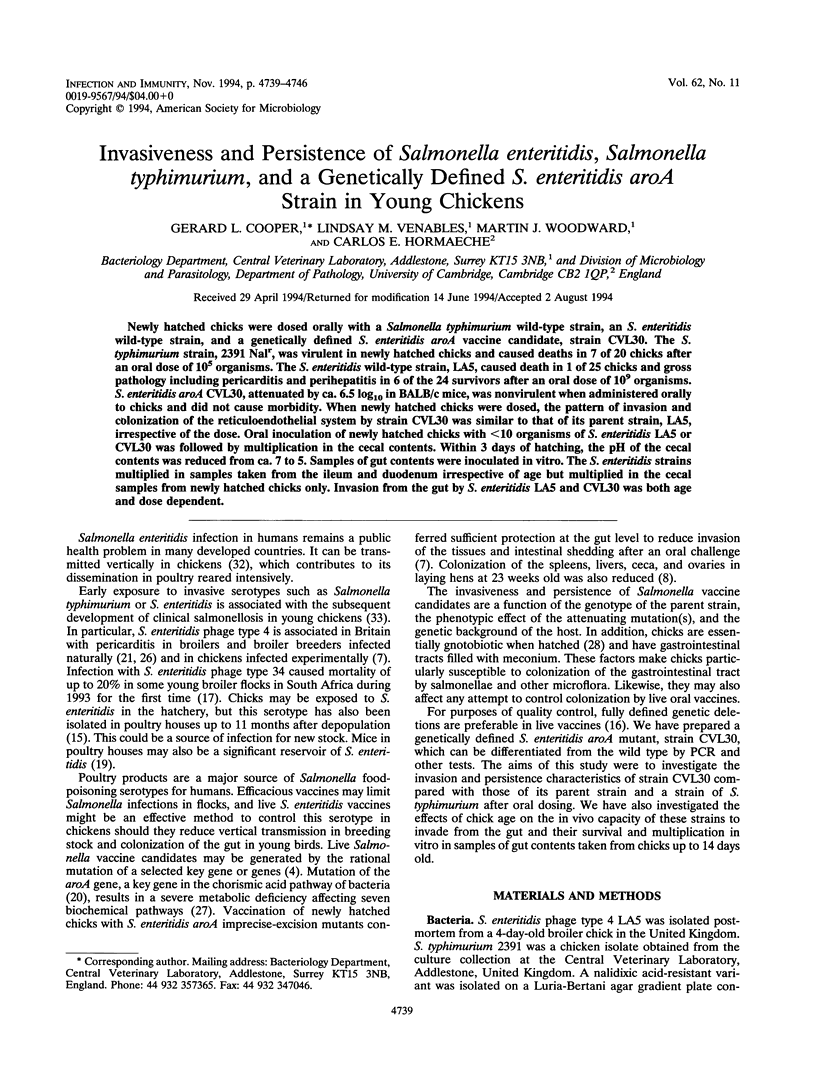
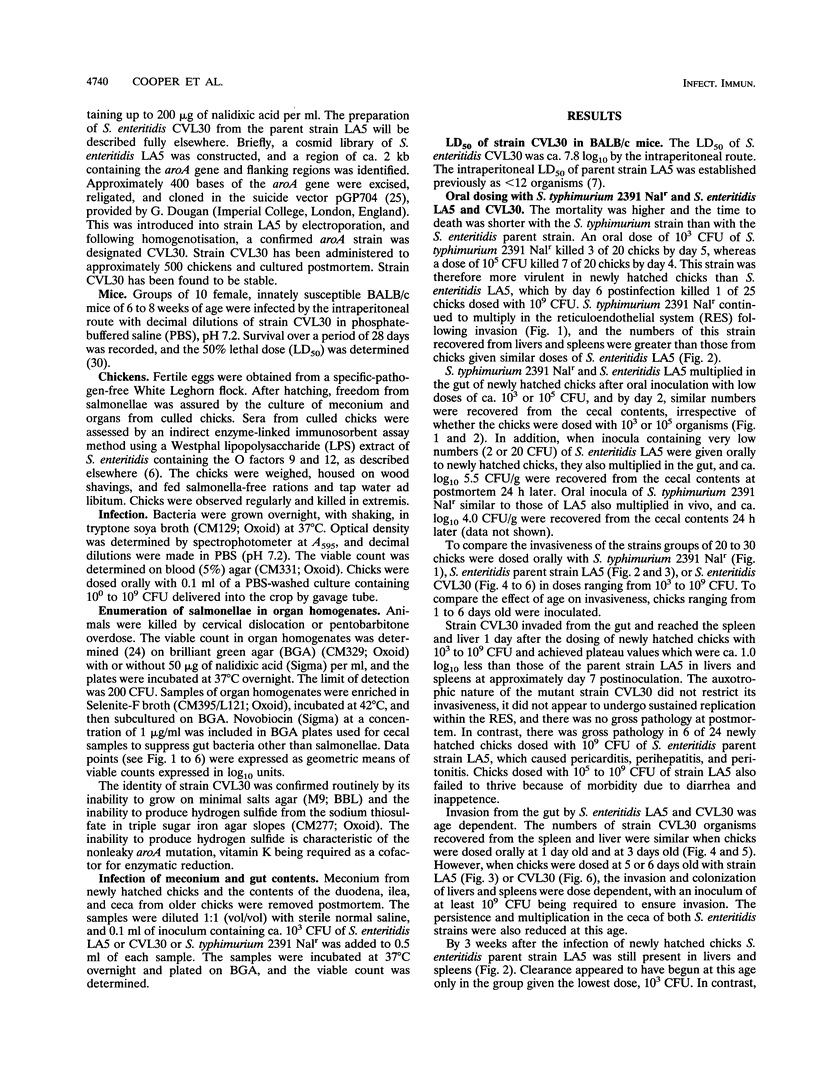
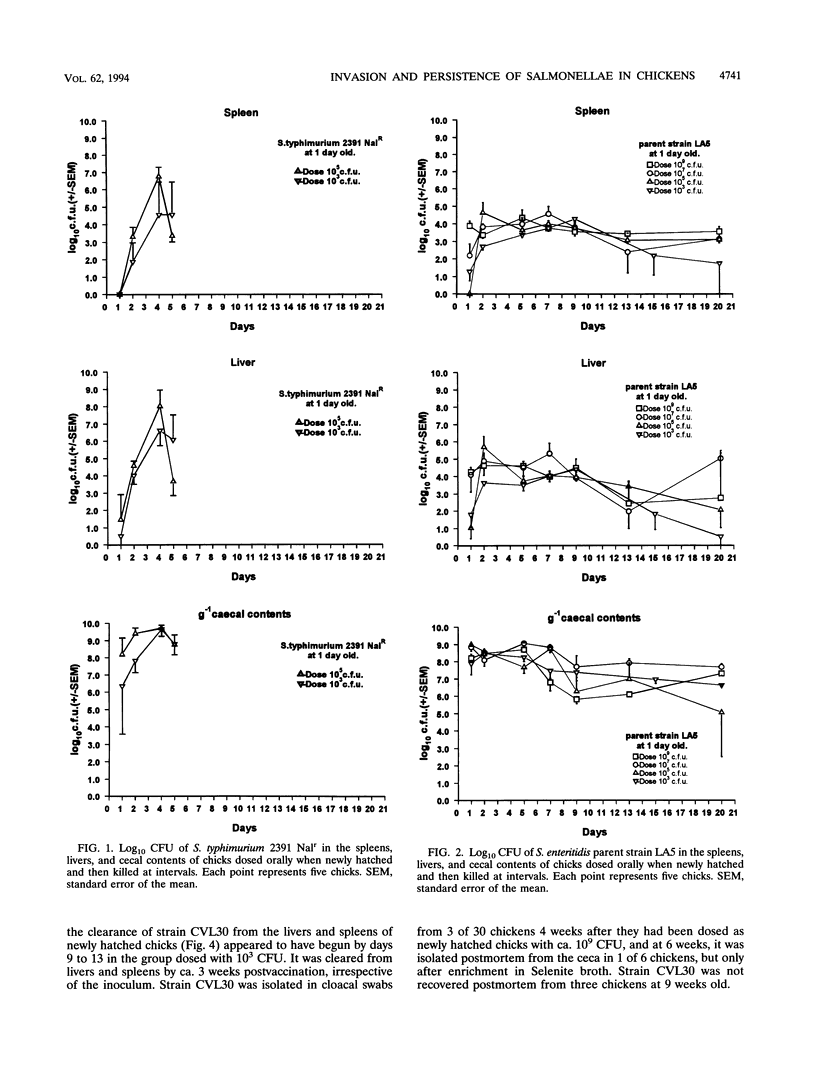
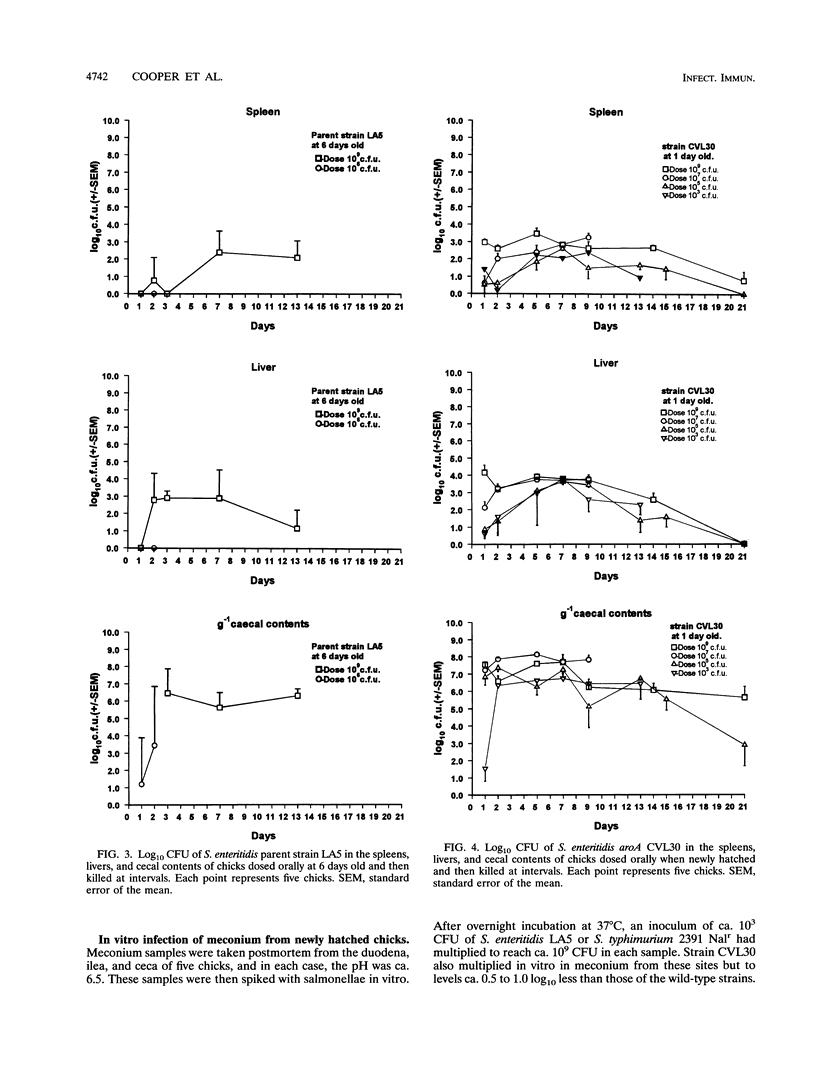

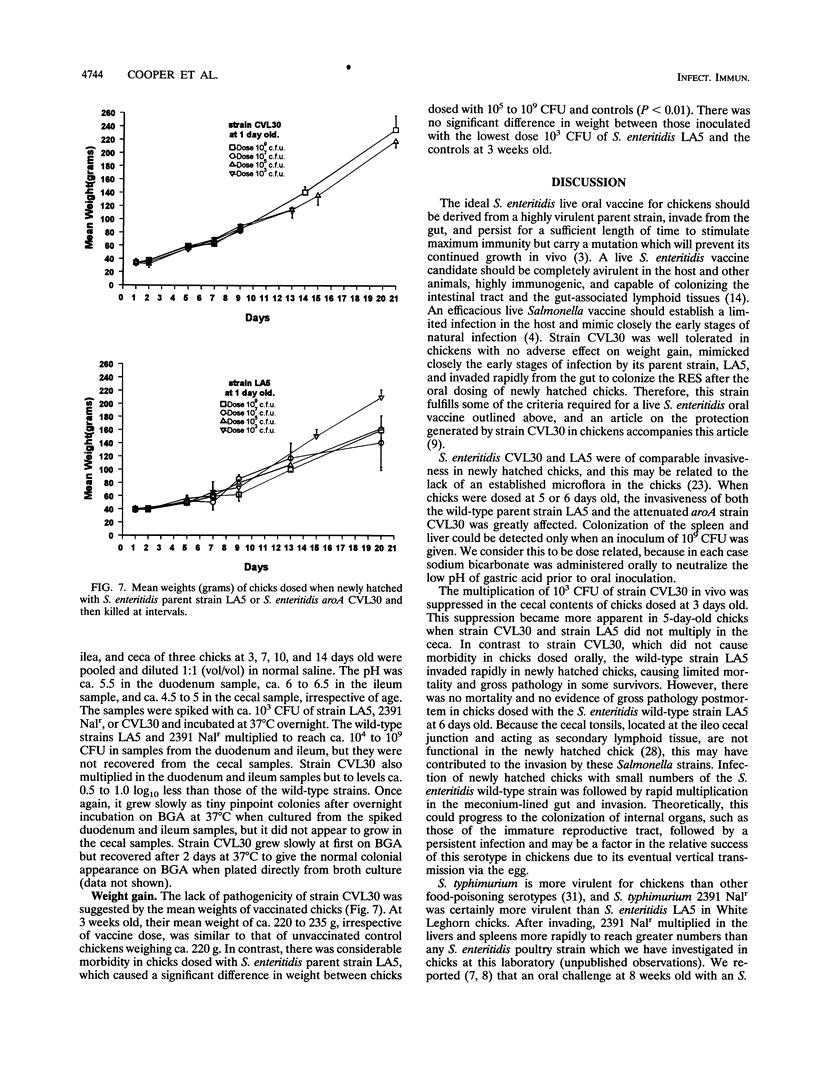
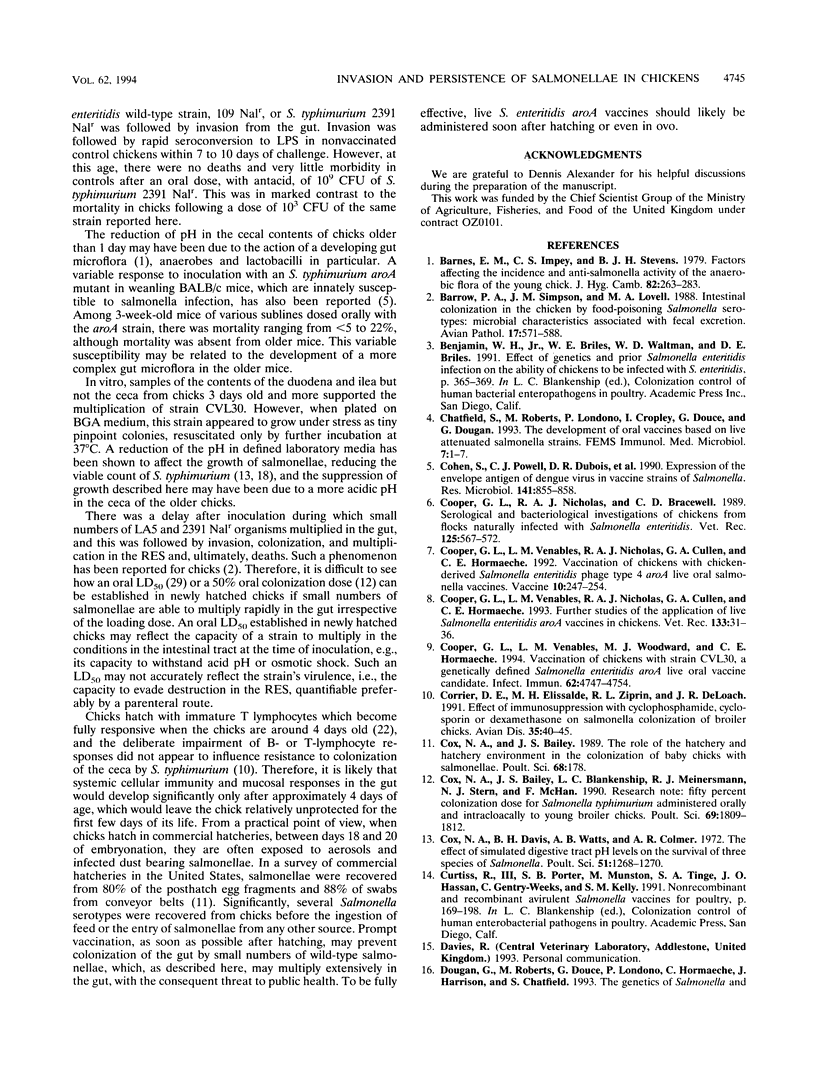
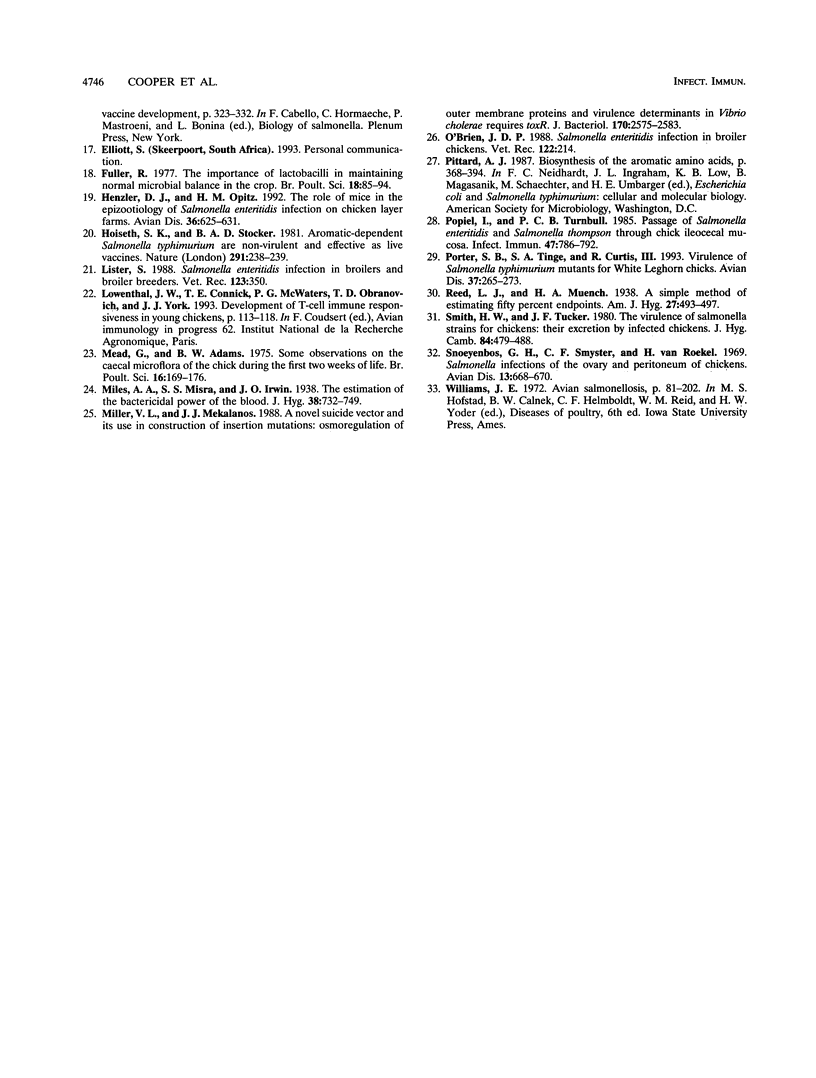
Selected References
These references are in PubMed. This may not be the complete list of references from this article.
- Barnes E. M., Impey C. S., Stevens B. J. Factors affecting the incidence and anti-salmonella activity of the anaerobic caecal flora of the young chick. J Hyg (Lond) 1979 Apr;82(2):263–283. doi: 10.1017/s0022172400025687. [DOI] [PMC free article] [PubMed] [Google Scholar]
- Chatfield S., Roberts M., Londono P., Cropley I., Douce G., Dougan G. The development of oral vaccines based on live attenuated Salmonella strains. FEMS Immunol Med Microbiol. 1993 Jun;7(1):1–7. doi: 10.1111/j.1574-695X.1993.tb00374.x. [DOI] [PubMed] [Google Scholar]
- Cohen S., Powell C. J., Dubois D. R., Hartman A., Summers P. L., Eckels K. H. Expression of the envelope antigen of dengue virus in vaccine strains of Salmonella. Res Microbiol. 1990 Sep-Oct;141(7-8):855–858. doi: 10.1016/0923-2508(90)90121-6. [DOI] [PubMed] [Google Scholar]
- Cooper G. L., Nicholas R. A., Bracewell C. D. Serological and bacteriological investigations of chickens from flocks naturally infected with Salmonella enteritidis. Vet Rec. 1989 Dec 2;125(23):567–572. [PubMed] [Google Scholar]
- Cooper G. L., Venables L. M., Nicholas R. A., Cullen G. A., Hormaeche C. E. Further studies of the application of live Salmonella enteritidis aroA vaccines in chickens. Vet Rec. 1993 Jul 10;133(2):31–36. doi: 10.1136/vr.133.2.31. [DOI] [PubMed] [Google Scholar]
- Cooper G. L., Venables L. M., Nicholas R. A., Cullen G. A., Hormaeche C. E. Vaccination of chickens with chicken-derived Salmonella enteritidis phage type 4 aroA live oral Salmonella vaccines. Vaccine. 1992;10(4):247–254. doi: 10.1016/0264-410x(92)90160-l. [DOI] [PubMed] [Google Scholar]
- Cooper G. L., Venables L. M., Woodward M. J., Hormaeche C. E. Vaccination of chickens with strain CVL30, a genetically defined Salmonella enteritidis aroA live oral vaccine candidate. Infect Immun. 1994 Nov;62(11):4747–4754. doi: 10.1128/iai.62.11.4747-4754.1994. [DOI] [PMC free article] [PubMed] [Google Scholar]
- Corrier D. E., Elissalde M. H., Ziprin R. L., DeLoach J. R. Effect of immunosuppression with cyclophosphamide, cyclosporin, or dexamethasone on Salmonella colonization of broiler chicks. Avian Dis. 1991 Jan-Mar;35(1):40–45. [PubMed] [Google Scholar]
- Cox N. A., Bailey J. S., Blankenship L. C., Meinersmann R. J., Stern N. J., McHan F. Fifty percent colonization dose for Salmonella typhimurium administered orally and intracloacally to young broiler chicks. Poult Sci. 1990 Oct;69(10):1809–1812. doi: 10.3382/ps.0691809. [DOI] [PubMed] [Google Scholar]
- Cox N. A., Davis B. H., Watts A. B., Colmer A. R. Salmonella in the laying hen. 2. The effect of simulated digestive tract pH levels on the survival of the three species of Salmonella. Poult Sci. 1972 Jul;51(4):1268–1270. doi: 10.3382/ps.0511268. [DOI] [PubMed] [Google Scholar]
- Fuller R. The importance of Lactobacilli in maintaining normal microbial balance in the crop. Br Poult Sci. 1977 Jan;18(1):85–94. doi: 10.1080/00071667708416332. [DOI] [PubMed] [Google Scholar]
- Henzler D. J., Opitz H. M. The role of mice in the epizootiology of Salmonella enteritidis infection on chicken layer farms. Avian Dis. 1992 Jul-Sep;36(3):625–631. [PubMed] [Google Scholar]
- Hoiseth S. K., Stocker B. A. Aromatic-dependent Salmonella typhimurium are non-virulent and effective as live vaccines. Nature. 1981 May 21;291(5812):238–239. doi: 10.1038/291238a0. [DOI] [PubMed] [Google Scholar]
- Lister S. A. Salmonella enteritidis infection in broilers and broiler breeders. Vet Rec. 1988 Sep 24;123(13):350–350. doi: 10.1136/vr.123.13.350. [DOI] [PubMed] [Google Scholar]
- Mead G. C., Adams B. W. Some observations on the caecal microflora of the chick during the first two weeks of life. Br Poult Sci. 1975 Mar;16(2):169–176. doi: 10.1080/00071667508416174. [DOI] [PubMed] [Google Scholar]
- Miller V. L., Mekalanos J. J. A novel suicide vector and its use in construction of insertion mutations: osmoregulation of outer membrane proteins and virulence determinants in Vibrio cholerae requires toxR. J Bacteriol. 1988 Jun;170(6):2575–2583. doi: 10.1128/jb.170.6.2575-2583.1988. [DOI] [PMC free article] [PubMed] [Google Scholar]
- O'Brien J. D. Salmonella enteritidis infection in broiler chickens. Vet Rec. 1988 Feb 27;122(9):214–214. doi: 10.1136/vr.122.9.214-b. [DOI] [PubMed] [Google Scholar]
- Popiel I., Turnbull P. C. Passage of Salmonella enteritidis and Salmonella thompson through chick ileocecal mucosa. Infect Immun. 1985 Mar;47(3):786–792. doi: 10.1128/iai.47.3.786-792.1985. [DOI] [PMC free article] [PubMed] [Google Scholar]
- Porter S. B., Tinge S. A., Curtiss R., 3rd Virulence of Salmonella typhimurium mutants for White Leghorn chicks. Avian Dis. 1993 Apr-Jun;37(2):265–273. [PubMed] [Google Scholar]
- Snoeyenbos G. H., Smyser C. F., Van Roekel H. Salmonella infections of the ovary and peritoneum of chickens. Avian Dis. 1969 Aug;13(3):668–670. [PubMed] [Google Scholar]
- Williams Smith H., Tucker J. F. The virulence of salmonella strains for chickens: their excretion by infected chickens. J Hyg (Lond) 1980 Jun;84(3):479–488. doi: 10.1017/s0022172400027017. [DOI] [PMC free article] [PubMed] [Google Scholar]


